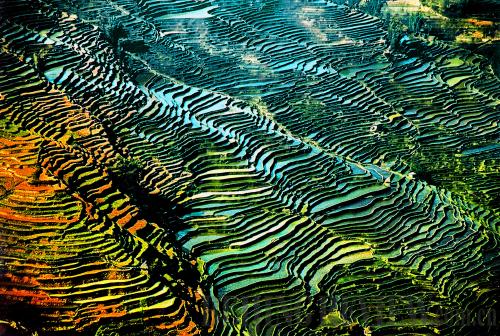|
 |
|
HERITAGE SITE: Honghe Hani Rice Terraces (CFP) |
This summer, the Cultural Landscape of Honghe Hani Rice Terraces in southwest China's Yunnan Province reached a major milestone, 10 years after the local government first set out to make the location a world-class tourist site.
At last, it was successfully inscribed on the UNESCO World Heritage List at the 37th session of the UNESCO World Heritage Committee in Phnom Penh, capital of Cambodia, on June 22.
The Cultural Landscape of Honghe Hani Rice Terraces is the 45th world heritage site in China and the first associated with the Hani ethnic minority.
Tong Mingkang, Deputy Director of State Administration of Cultural Heritage, said at the plenary session, "The cultural landscape of Hani terraces is a unique production pattern of local agriculture and the heritage of the traditions and beliefs of the Hani people, reflecting the respect for tradition and nature by local people."
Unique landscape
Hani terraces, located in Yuanyang County, Honghe Hani and Yi Autonomous Prefecture in Yunnan Province, cover 461 square km in total. The inscribed world heritage area, covering 166 square km, displays the most concentrated and best-developed terraces in three valleys where 80,000 people from Hani and six other ethnic groups live in 82 villages. Visitors are often enchanted by the grand man-made rice cultivation terraces alongside steep mountain slopes.
Over the past decade, this land of idyllic beauty has been discovered by more and more people around the world. In particular, Honghe Hani Rice Terraces displayed a perfect blend of rice farming and natural landscape in a documentary entitled Wild China, produced by the BBC in association with China Central Television in 2008.
As noted in Wild China, "Chinese have been cultivating rice for at least 8,000 years. It has transformed the landscape."
Hani terraces present a living history book of rice cultivation. According to historical records, the Honghe Hani Rice Terraces can be dated to more than 1,300 years ago.
"Yunnan's rice terraces are among the oldest human structures in China, still ploughed, as they always have been, by domesticated water buffalo, whose ancestors originated in these very valleys," said the narrator of Wild China.
Over the past 1,300 years, the Hani people have developed the local landscape into a harmonious ecological system consisting of four key parts—forests, villages, terraced paddies and water, said Zhang Hongzhen, nomination group leader and Director of Hani Rice Terraces Administrative Bureau.
The mountaintop forests are the lifeblood of the system, capturing the water that makes irrigation possible.
"The forests are the only reservoir," said Zhang.
Forest vegetation atop mountains collects rainwater and carries it into springs and rivers. The Hani people built a complex system of channels to bring water from the forested mountaintops to the terraces along the hill slope. At the bottom of valleys, water evaporates into the upper atmosphere, cooling and again dropping onto the mountain as rain, which forms an ecological cycle, he explained.
The Hani people traditionally believe the woodlands are home to their village god Angma, whose name translates to Village's Soul, and their land-protection deity Misong, who blesses them with peace and prosperity.
The swampy ground provides ideal conditions for a remarkable crop—rice. This man-made landscape is one of the most amazing engineering feats of pre-industrial China. It looks as if every square inch of land has been ploughed into cultivation. The integrated farming system also involves buffalo, cattle, ducks, fish, eels and other animals.
The culture and religious beliefs of local people center on terraced paddies. The Hani inhabitants worship the sun, moon, mountains, rivers, forests and fire.
| 